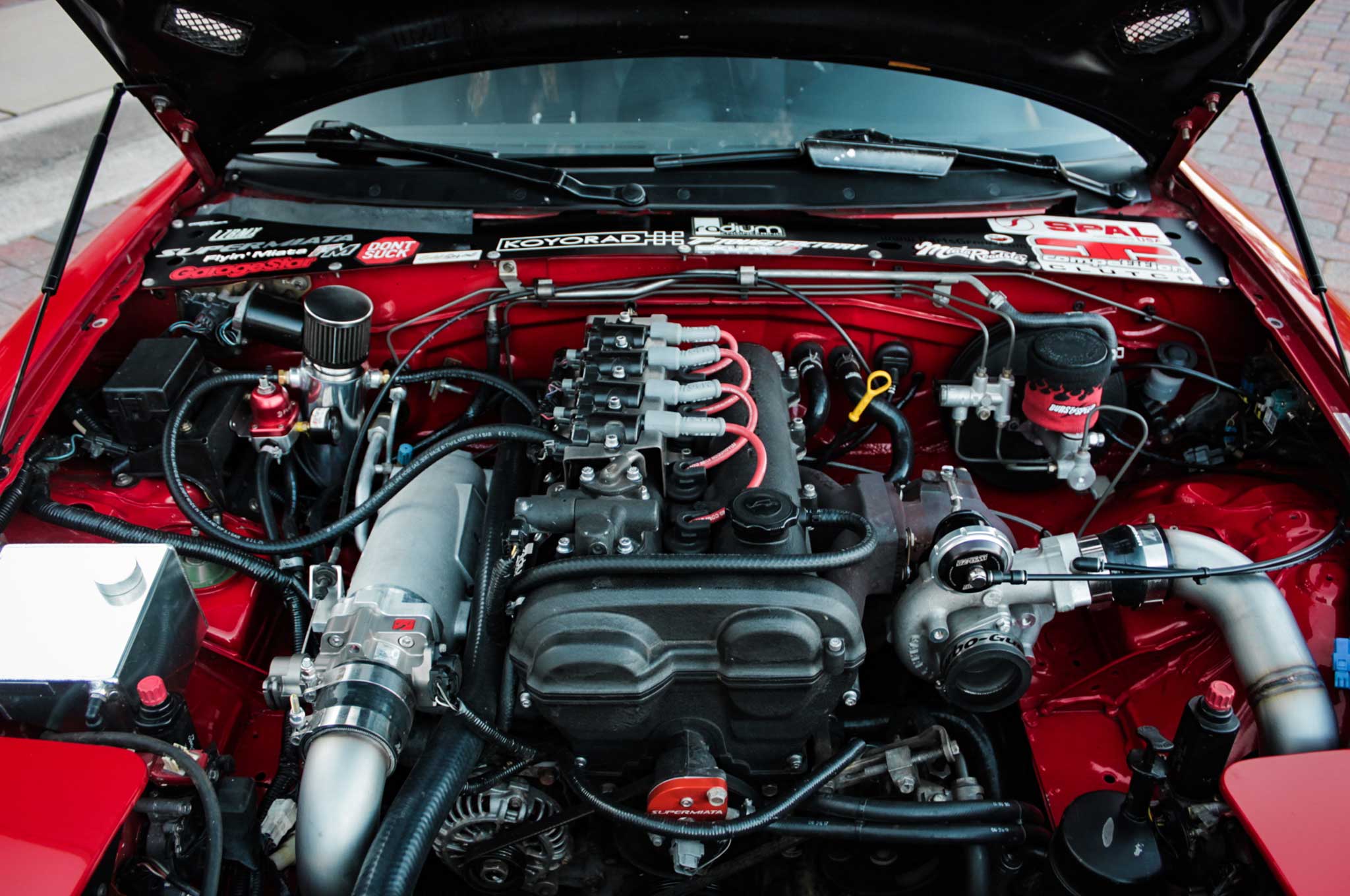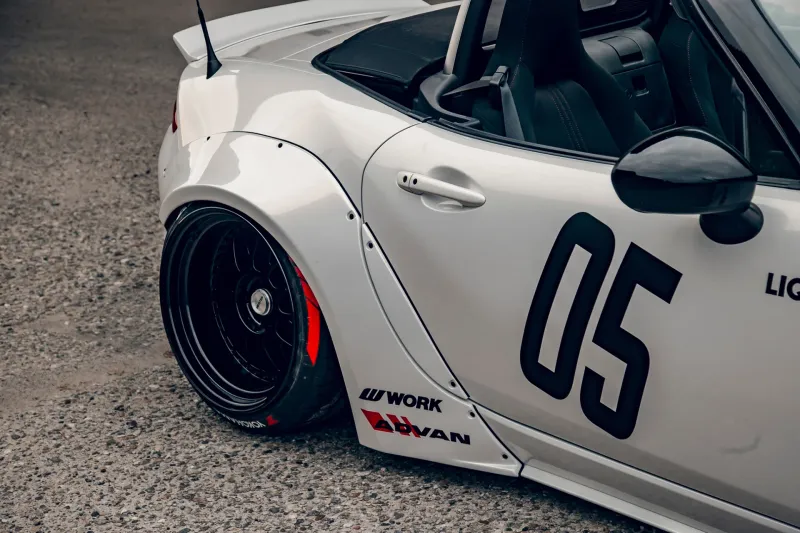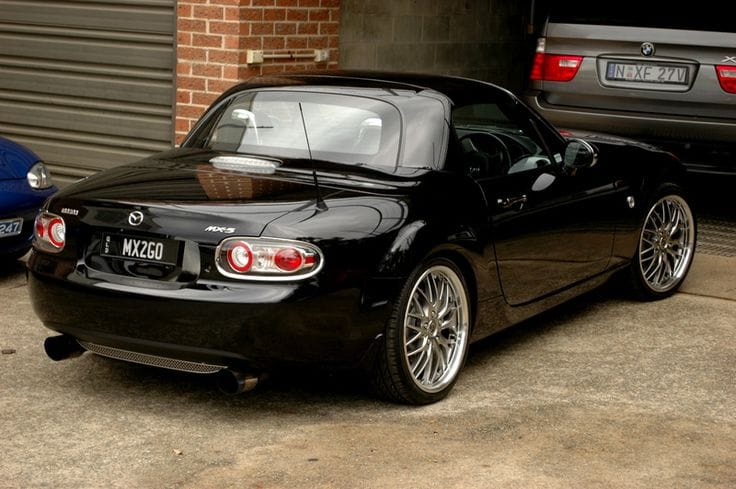The Ultimate Mazda MX-5 Turbo Build Parts List
Before adding power, make sure your Miata’s engine is healthy. Run compression and leak-down tests, replace worn plugs, belts, and fluids, and inspect every vacuum hose. Fix any oil or coolant leaks now—boost will only make them worse.

Before you bolt on anything shiny, make sure the engine is healthy. Start by running compression and leak-down tests to confirm every cylinder is sealing properly. Swap in fresh plugs, belts, and fluids, then trace every vacuum hose you can see and replace anything that feels brittle. Hunt down oil and coolant weeps now, because boost turns a slow seep into a smoky mess. Finally, upgrade the cooling system with a high-flow thermostat and a 1.3-bar radiator cap so the stock radiator stands a fighting chance once you add pressure.
Core Turbo Hardware
The story begins with the manifold and turbo. A cheap cast-log manifold paired with a small Garrett GT2554R is perfect for the low-two-hundreds horsepower crowd and still drives like a factory car around town. Mid-level builders usually grab a Kraken semi-tubular manifold and a GT2560R or TD05-16G, which lands them near three-hundred wheel horsepower without turning the engine bay into spaghetti. Anyone chasing big numbers gravitates to an equal-length stainless manifold and a BorgWarner EFR 6258, but they also spend extra time fabricating braces so nothing cracks. Wastegate and blow-off-valve choices follow the same budget-to-baller ladder, from simple off-brand pieces that “just work” to TiAL hardware that keeps boost rock-steady lap after lap. Regardless of budget, weld a wideband oxygen-sensor bung into the down-pipe before it goes on the car, and pick an intercooler that clears the air-conditioning condenser so you are not hacking up bodywork later.

Engine Management and Fuel
Forced induction demands a real standalone ECU; piggyback systems simply cannot pull timing quickly enough if the engine starts to knock. Speedy EFI and older Megasquirt units offer an inexpensive entry point, while ME221 or MS3 models add knock control, closed-loop boost, and more data logging. Pair the ECU with a fast-response wideband, then choose injectors only after you have settled on a horsepower target. Most street builds live happily with 640-cc Bosch EV14 injectors and an AEM 320-lph pump, but anyone who wants a little headroom should jump to one-thousand-cc injectors and a Walbro 450 in-tank pump feeding a six-AN line. Finish the system with an ECU-controlled three-port solenoid so you can tailor boost for each gear and spare the differential from sudden torque spikes.
Cooling and Lubrication
Boost adds heat everywhere, so cooling matters. A Mishimoto or Koyorad two-row radiator handles spirited street use, while hot-climate track cars appreciate the thicker Koyorad core. An oil-cooler is cheap insurance: a nineteen-row Setrab paired with an eighty-degree thermostatic sandwich plate drops sump temperatures from one-hundred-thirty degrees Celsius to roughly one-hundred even after a hard session. A coolant reroute that moves the thermostat to the rear of the cylinder head evens out temperature differences between the hot and cold ends of the block. Feed the turbo with a four-AN line sporting a restrictor if it is a ball-bearing unit, and use a ten-AN gravity drain that empties above the oil level in the pan.

Drivetrain and Clutch
Clutch and differential choices scale with power. Up to three-hundred wheel horsepower, a Competition Clutch Stage 3 paired with a five-kilogram flywheel works fine with the stock torsen. Beyond that, a Stage 4 six-puck disc and a slightly lighter flywheel make sense, backed by an NB four-point-one torsen and sturdier axle stubs. Anything above three-hundred-fifty invites an ACT XT-M pressure plate, a chromoly flywheel, a Kaaz one-and-a-half-way clutch diff, and purpose-built upgraded axles. A light flywheel makes rev-matching addictive, but expect more gearbox chatter when idling in neutral.

Electronics and Safety
Add a three-bar MAP sensor so the ECU still knows what is happening past twenty-two pounds of boost, and install a fast-response inlet-air-temperature sensor in the cold-side charge pipe. Monitor oil pressure and temperature, fuel pressure, and air-fuel ratio on gauges you can actually see from the driver’s seat. For track work, a Hard Dog M2 Sport roll-bar and a small HalGuard extinguisher tick the usual tech-inspection boxes.

Optional “Stage 2” Upgrades
Once the core setup is dialed, lighter propshafts sharpen throttle response, while water-meth injection trims inlet temperatures and adds a reliable twenty horsepower on pump fuel. A properly plumbed catch-can keeps oil out of the intercooler, and a coil-on-plug conversion maintains spark strength at high boost or on ethanol blends.
A bare-bones two-hundred-and-thirty-horsepower build runs four-grand in parts if you shop carefully. A well-rounded three-hundred-horsepower street-and-track setup lands closer to seven-grand, while a full race package with an EFR turbo, clutch-type differential, water-meth kit, and aero easily breaks the ten-thousand-dollar mark. Labour, suspension, wheels, and the inevitable “while I’m in there” upgrades add extra zeros if you are not turning your own wrenches.
Sequencing the Build
Keep the car drivable by working in sensible steps: start with the health check and cooling upgrades, install the standalone ECU and wideband while the engine is still naturally aspirated, build out the fuel system and clutch next, then bolt on the turbo kit and intercooler. Upgrade the differential and axles once the new torque level justifies it, and add oil cooling, catch-cans, and safety gear before any track day. Only after those essentials are sorted should you step up to water-meth, a larger turbo, or an internally built engine.
Many first-timers buy injectors before they have picked a turbo, only to find the flow rate is wrong for their actual power target. Others rely on piggyback fuel controllers and discover too late that the system cannot yank timing fast enough when detonation starts. Skipping a hard boost cut invites over-boost when a vacuum line pops off, and choosing overly tall gearing lets the engine fall out of the boost window on every shift. Finally, remember that three-hundred horsepower on skinny all-season tyres turns the first hard pull into a comedy sketch.
There is no single “best” MX-5 turbo recipe, only the package that fits your horsepower goal, budget, and driving style. Nail those three variables and the humble roadster punches far above its weight every time the wastegate chirps, whether you spent four-grand or four times that amount.




